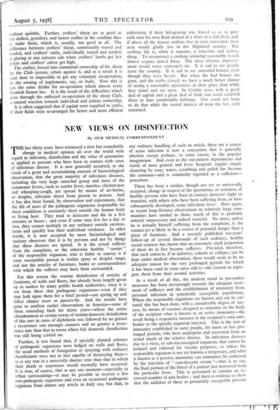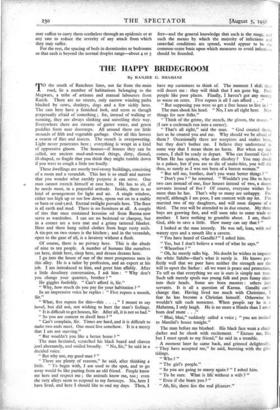NEW VIEWS ON DISINFECTION
By OUR MEDICAL CORRESPONDENT
THE last thirty years have witnessed a slow but remarkable change in medical opinion all over the world with regard• to infection, disinfection and the value of quarantine as applied to persons who have been in contact with cases of infectious disease. It is now generally accepted, as the result of a great and accumulating amount of bacteriological observation, that the great majority of infectious diseases, including the very large catarrhal group and most of the commoner fevers, such as scarlet fever, measles, chicken-pox and" Whiooping-cough, are spread by means of air-borne, or droplet, infection direct from person to person. And it has also been found, by observation and experiment, that the life of most of the pathogenic organisms responsible for these conditions is extremely short outside the human body or living host. They tend to desiccate and die in a few minutes or hours ; and even if some may live for a day or two, they cannot multiply in any ordinary outside environ- ment and quickly lose their individual virulence. In other words, it is now accepted by most bacteriological and sanitary observers that it is by persons and not by things that these diseases are spread. It is the actual sufferer from the complaint, or the otherwise healthy " carrier " of the responsible organism, who is liable to convey it if some susceptible person is within spray or droplet range, and not the articles of furniture, books or correspondence with which the sufferer may have been surrounded.
For this reason the routine disinfection of articles of furniture, of walls and floors, has already been largely given up as useless by many public health authorities, since it is not from these that pathogenic organisms—even if they may lurk upon them for a brief period—can spring up and infect chance users or passers-by. And the results have gone to confirm earlier observations in America—some of them extending back for thirty years—where the entire abandonment in certain towns of routine domestic disinfection of this sort in cases of diphtheria was followed by no greater a recurrence rate amongst contacts and no greater a recur- rence rate than that in towns where full domestic disinfection was still being carried on.
Further, it was found that, if specially planted colonies of pathogenic organisms were lodged on walls and floors, the usual methods of fumigation or spraying with ordinary disinfectants were not in fact capable of destroying them— or at any rate in a materially shorter time than that in which their death or impotence would normally have occurred. It is true, of course, that at any one moment—especially in urban surroundings—it may be possible to recover a few non-pathogenic organisms and even an occasional pathogenic organism from almost any' article in' daily use, but that, in any ordinary handling of such an article, these are a source of acute infection is now a conception that is generally obsolete except perhaps, to some extent, in the popular imagination. And even in the out-patient departments and wards of most general and fever hospitals regular simple cleansing by soap, water, scrubbing and polish has become the common—and is commonly regarded as a sufficient— procedure.
There has been a similar, though not yet so universally accepted, change in respect of the quarantine, or isolation, of healthy persons who have been in contact, however slight or transient, with others who have been suffering from, or have subsequently developed, some infectious fever. Here again, as recent long-distance observations in relatively large com- munities have tended to show, much of this is probably entirely unnecessary and indeed wasteful. No more, unless he is actually himself suffering from the complaint, is the contact per se likely to be a source of potential danger than a piece of furniture. And a recently published ten-years' follow-up of several thousands of such ordinary, healthy casual contacts has shown that an extremely small proportion of them do in fact become sufferers. Provided, therefore, that such contacts, if in industry, schools or colleges, can be kept under medical observation, there would seem to be no adequate reason for the very prolonged periods for which it has been—and in some cases still is—the custom to segre- gate them from their normal activities.
As a result of all this, the modern trend in preventive measures has been increasingly towards the adequate treat- ment of sufferers and the establishment of immunity from personal infection in potentially susceptible populations. Where the responsible organisms are known and can be cul- tured this has been done, with a considerable degree of suc- cess, by means of vaccines designed to stimulate in the body of the recipient what is known as an active immunity—the result being a responsive increase in the recipient's own anti- bodies to the specific organism injected. This is the sort of immunity established in most people, for more or less pro- longed periods, who have undergone and recovered from an actual attack of the relative disease. In infectious diseases due to a virus, or sub-microscopical organism, that cannot be isolated and cultured for vaccine purposes, or where the responsible organism is not yet known, a temporary, and what is known as a passive, immunity can sometimes be conferred by the injection of " convalescent serum "—that is to say, the fluid portion of the blood of a patient just recovered from the particular fever. This is presumed to contain an in- creased number of anti-bodies ; and there is evidence to show that the addition of these to potentially susceptible persons may suffice to carry them scatheless through an epidemic or at feet—and the general knowledge that such is the range, and any rate to reduce the severity of any attack from which such the means by which the majority of infections and they may suffer. catarrhal conditions are spread, would appear to be the For the rest, the spacing of beds in dormitories or bedrooms common-sense basis upon which measures to avoid infections so that each is beyond the normal droplet range—about 4 or 5 should be founded.



































 Previous page
Previous page